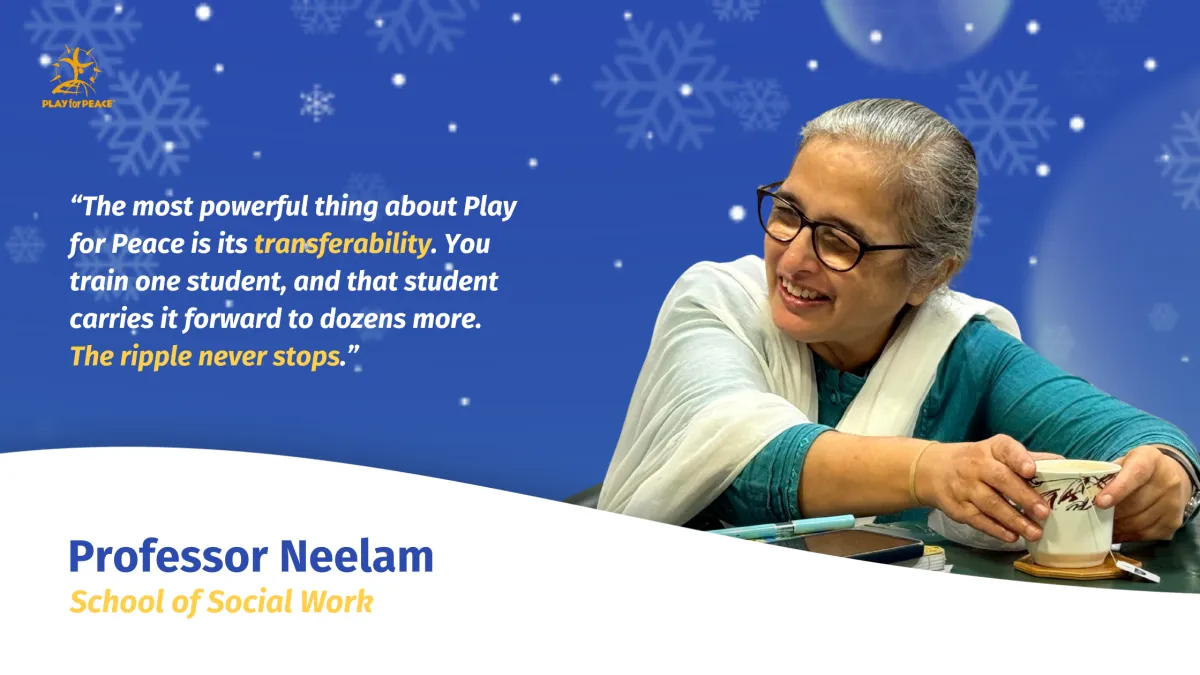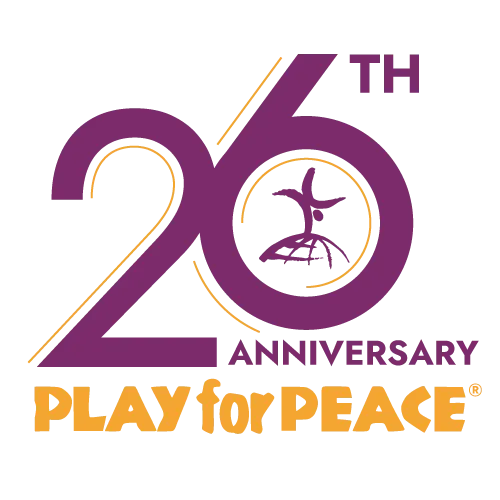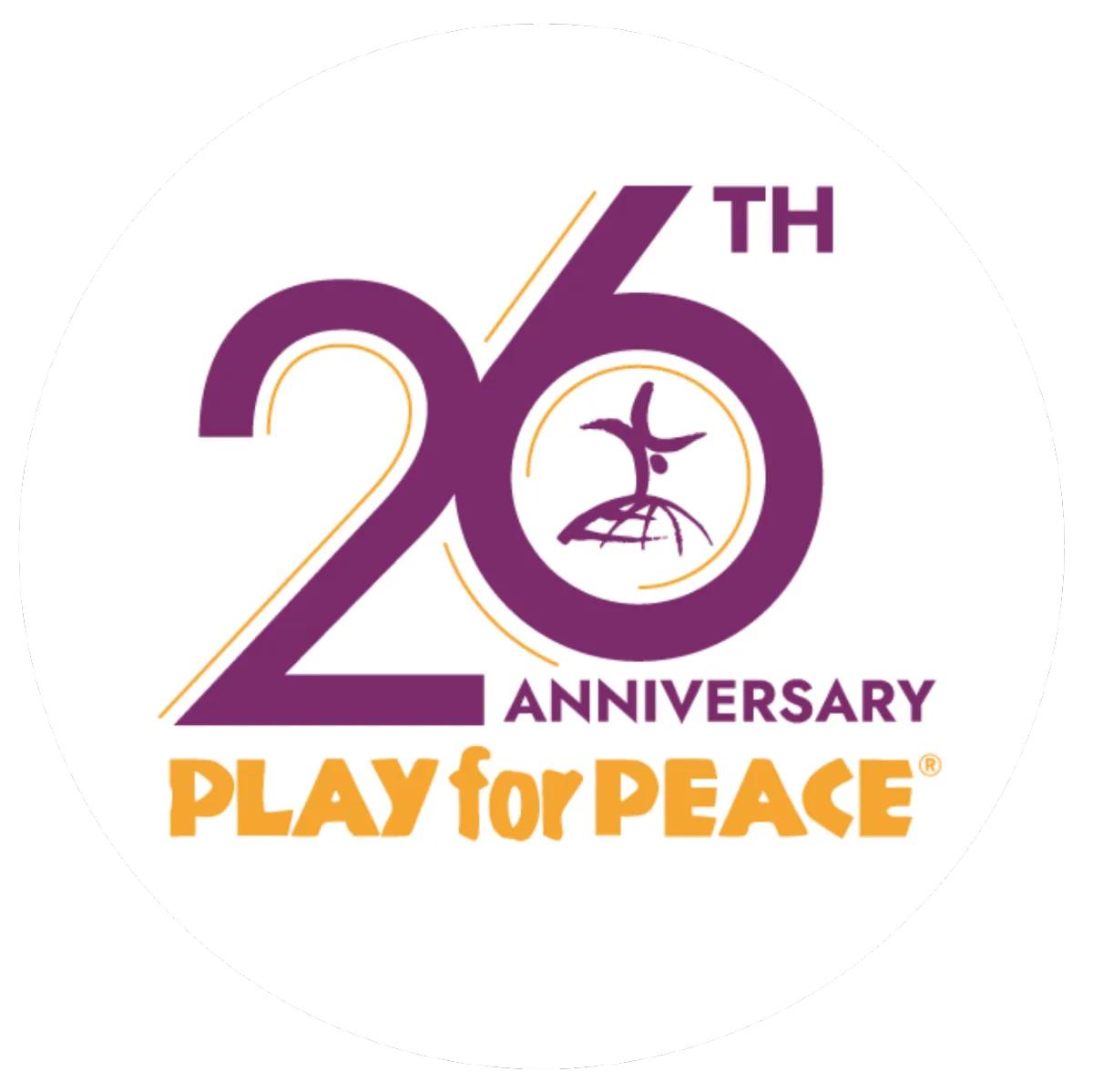
Professor Neelam’s Ripple of Peace
When Professor Neelam proposed a simple question—could life skills education be intentionally designed for peacebuilding?—she began something that would ripple far beyond her classroom. What started as a three-day workshop quickly became a curriculum innovation, a community practice, and a growing movement: students trained in Play for Peace began carrying games, empathy, and nonviolent communication into schools, refugee camps, disaster zones, corporations, and youth clubs across India and beyond.

A Professor’s Conviction: Play that Transfers to the Field
Professor Neelam first invited Play for Peace facilitators to deliver a short, focused module for her social work students. The intention was practical: develop a life-skills curriculum that could be used in real community settings. What she discovered in the months that followed surprised even her.
Students who learned Play for Peace methods didn’t leave the learning behind. On field placements—whether in villages, flood-impacted areas, or youth clubs—they transferred those facilitation skills immediately, using cooperative games to open conversation, create safe spaces, and support children dealing with trauma. That transferability convinced Neelam that play wasn’t just a classroom add-on; it was a scalable, practical tool for peacebuilding in the field.
“When students go into the community, they don’t just memorize techniques—they use them. That cascading effect reaches far more people than a single workshop ever could,” Neelam reflected.
From a Three-Day Workshop to an Institutional Curriculum
After the initial sessions, Play for Peace was integrated as a formal part of the curriculum. What changed?
The program moved from occasional add-ons to a structured 16-hour group play curriculum, delivered across multiple sessions.
Students were required to practice by facilitating real sessions in nearby schools—an exercise that boosted their confidence and demonstrated the method’s impact to school leaders. One principal invited the students back to train teachers under the new education policy.
Those practice sessions proved critical. Student facilitators who were initially unsure found themselves energized when children responded with joy and engagement. The result: stronger retention, more confident facilitators, and increased institutional interest.
Real-World Impact: Kashmir, Flood Relief, and Corporate Training
The blog of impact is long and varied:
In Jammu & Kashmir, local youth clubs used Play for Peace activities to help children process conflict-related trauma.
After sudden flash floods, teams adapted games to bring small moments of relief and joy to families facing devastation—memories that survivors say help sustain resilience.
Even the corporate sector saw benefits: a team that remembered Play for Peace from university later invited trained students to design team-building activities—proof that these methods translate across contexts.
These examples show how play can meet people where they are—whether overwhelmed by grief or navigating everyday stress—and give them simple, shared moments of connection.
The Power of Memory and Long-Term Healing
One poignant story stands out: an experiential educator attending a Play for Peace session recognized, after 28 years, the exact game that sparked her lifelong passion. That memory—small, playful, vivid—revealed a powerful truth: playful experiences can become lifetime catalysts, shaping career choices and personal healing long after the session ends.
That is the work’s quiet promise: micro-level interventions (games, sessions, moments of play) can create durable, positive memories that withstand macro-level political traumas.
Practical Lessons: Reinforcement, Resources, and Inclusiveness
The faculty and trainers collected practical, on-the-ground learning:
Reinforcement matters. One workshop is rarely enough. Ongoing mentoring, demonstration sessions, and opportunities to practice build confidence and quality facilitation.
Write it down. Facilitators prepared booklets of games and created short video resources so newcomers could refresh basics before innovating. Memory is fallible; written and visual references keep practice alive.
Digital support helps. The Kikori app emerged as a valuable tool—hosting games, modules, and author contacts so trained facilitators can revisit activities and continue learning remotely.
Inclusiveness is central. Unlike competitive games that risk exclusion, Play for Peace activities are designed so everyone can belong. That lack of threat is what allows joy and learning to flourish.
A Cascading Movement: Students as Multipliers
Professor Neelam’s students became conduits: they trained teachers, ran sessions for schoolchildren, worked with NGOs, supported disaster relief, and even returned to corporate and community settings to deliver team-building work. Each trained student multiplied the reach of Play for Peace, creating a ripple effect that continues to spread.
As one trainer noted, the work is not a single intervention but a movement—spreadable, adaptable, and sustained by people who choose to bring play into their practice and their lives.
Challenges Acknowledged: Micro vs. Macro Realities
The team also faced honest questions. Can play-based, micro-level interventions influence macro political conflicts? Practitioners acknowledged limits—one game won’t end a war—but argued that these interventions matter: they build empathy, reduce intergenerational trauma, and create pockets of resilience that form the social fabric necessary for longer-term transformation.
Looking Forward: Training, Tools, and Collaboration
Next steps emerging from the work include:
Embedding Play for Peace more deeply into academic programs (social work, applied psychology) for sustained transferability.
Developing reinforcement models—mentoring, refresher trainings, and documented playbooks—to maintain quality.
Expanding digital support through Kikori so trained facilitators across regions can access modules and videos.
Continuing collaboration between universities, NGOs, and community groups to widen reach and deepen impact.
A Movement Bigger Than Any One of Us
What began as Professor Neelam’s curriculum idea has become proof of something simple and hopeful: when we teach people how to connect, to listen, and to play together, those practices spread. Students trained in classrooms become facilitators in communities; small games become memories that sustain resilience; and a single workshop can spark years of compassionate practice.
Play for Peace is not just an organization but a movement—and Professor Neelam’s work is one luminous example of how education can seed change that truly multiplies.
Give the Gift of Play and Belonging
This winter, help us amplify these ripples of peace. Your donation will fund facilitator training, learning resources, and digital tools (like the Kikori app) so more students, teachers, and community leaders can carry Play for Peace into classrooms, camps, and disaster response sites.
💛 Support the Winter Campaign — Bridges Through Play: Healing Divides
👉 Donate now and power the movement





